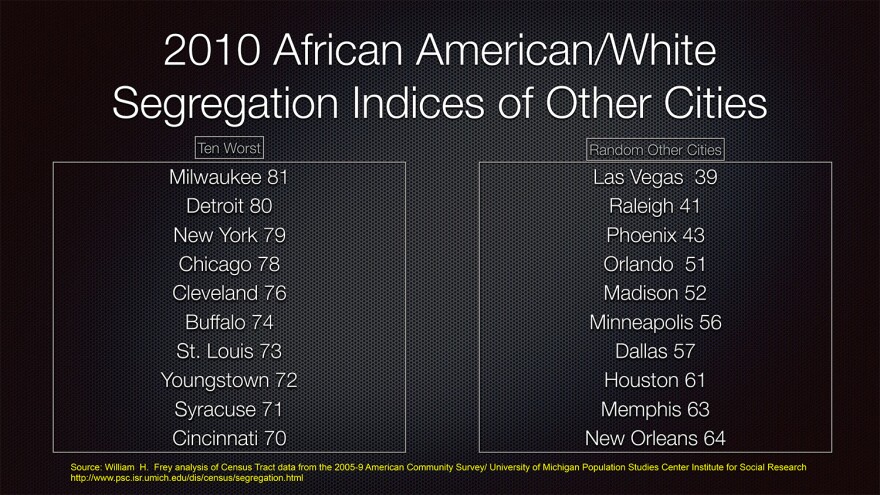The assertion that Milwaukee is currently one of - if not the most segregated metro area in the United States is probably deserved but with some qualifications, according to UW-Milwaukee researcher Marc Levine.
An extraordinary number of blacks live in the city as opposed to in Milwaukee suburbs, and in the city itself - while it is diverse, African-Americans, whites and Latinos tend to live in neighborhoods with little diversity.
Levine says he knows "most segregated" can be a loaded phrase, but adds, "there are lots of indicators of segregation and Milwaukee ranks high on all of them."

Levine heads the Center for Economic Development at UW-Milwaukee and has studied segregation extensively, breaking it down by zip code and census tract.
He explains that one of the standard ways social scientists measure segregation is with the index of dissimilarity, which “basically measures the degree to which you’d have to rearrange the local population by race to get a fairly even distribution.”
On that scale, 80 is hyper-segregation, 60 is segregation. According to 2010 Census data, the Milwaukee metro area scored an 80 on for white-black dissimilarity and a 57 for white-Hispanic. In that measure, Milwaukee is comparable, if slightly worse, than places like Cleveland, Detroit, Buffalo and Chicago – a swath, Levine says, could be called “the Segregation Belt” of the United States.

Metro Milwaukee’s index of dissimilarity, he says, has hovered around 80 for the last half-century. But so have those other cities. “So rather than use the moniker ‘most segregated’ city [for Milwaukee], say ‘among the four or five most segregated cities,’” he suggests.
One thing that does make Milwaukee unique is the degree to which the African-American population is concentrated in parts of the city itself – especially the near north and northwest sides.
"Milwaukee has the lowest rate of African-American suburbanization of any metropolitan area in the country."
Moreover, another demarcation line tends to be the boundaries of the City of Milwaukee. “90% of African-Americans households in metropolitan Milwaukee live in the City of Milwaukee. That’s a much higher percentage than in virtually every other metropolitan area in the country,” he explains.
Or, to put in another way, Levine says, “Milwaukee has the lowest rate of African-American suburbanization of any metropolitan area in the country.”
So, while just about 10% of black households live in metro Milwaukee’s suburbs, over 80% of white households live in the suburbs.
“To a degree that is relatively unique among American metropolitan areas, [however] Milwaukee still kind of conforms to the old model of a white suburban ring surrounding an increasingly African-American central city,” Marc Levine adds.
For more on this topic, explore our Project Milwaukee: Segregation Matters series.
Have questions about segregation in Milwaukee? Submit your query below.
_







